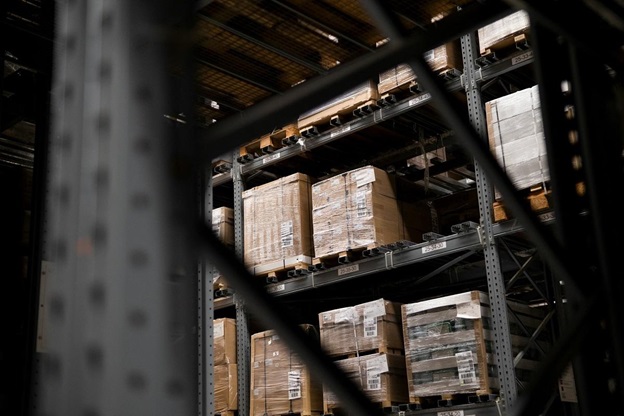Managing a warehouse effectively means more than just having enough space to store items. It requires a well-thought-out approach to space utilization, inventory management, and safety procedures. A significant part of this strategy involves having the right equipment. This essential warehouse equipment list will guide you through the must-haves for running a smooth, efficient, and safe operation.
1. Pallet Racks
One of the most fundamental pieces of equipment in any warehouse, pallet racks maximize space by allowing you to store materials vertically. They come in various types, such as selective, drive-in, push back, and cantilever racks, each designed for specific needs and space optimization.
2. Conveyor Idlers
Conveyor idlers play a pivotal role in the material handling sector by supporting the weight and impact of materials being transported along conveyor belts. These cylindrical conveyor idlers, strategically positioned along the conveyor framework, provide a smooth surface for the belt to roll on, reducing friction and enabling the belt to move effortlessly. Notably, idlers help in maintaining the integrity of the conveyor belt’s shape and trajectory as it conveys items from one point to another. They are designed in various forms—standard, impact, return, and self-aligning—to meet the unique needs of different industrial applications, ensuring both the longevity of the conveyor system and the preservation of materials being moved. By choosing the appropriate idler type and regularly maintaining these components, warehouses and production facilities can ensure increased efficiency and reduced operational downtime.
3. Shelving Units
For smaller items or those that don’t require pallet storage, shelving units are indispensable. They provide organized storage solutions and easy access to goods. Like pallet racks, shelving units come in various designs, including boltless, steel, and rivet shelving, tailored to different weight capacities and storage needs.
4. Forklifts
Forklifts are the workhorses of the warehouse. They are essential for moving heavy or bulky items quickly and efficiently. Depending on your warehouse environment and the type of goods you handle, you can choose from several types of forklifts, including counterbalance, reach trucks, and pallet jacks.
5. Conveyor Belts
For warehouses that handle a significant amount of shipping and receiving, conveyor belts are a must. They streamline the movement of goods across different areas of the warehouse, improving efficiency and reducing manual handling efforts.
6. Dock Equipment
Dock levelers, bumpers, seals, and shelters are essential for a smooth interface between the warehouse and transportation. This equipment ensures the safe and efficient loading and unloading of goods, minimizing the risk of injury and damage to merchandise.
7. Safety Gear and Equipment
Safety in the warehouse is paramount. Essential safety equipment includes fire extinguishers, first aid kits, safety signs and barriers, and personal protective gear such as hard hats, safety glasses, and high-visibility clothing. Regular training and safety drills are also essential to ensure that employees are prepared for any situation.
8. Warehouse Management Software (WMS)
In today’s digital age, a Warehouse Management System (WMS) is indispensable. It optimizes every aspect of your warehouse operation, from inventory management to order fulfillment, providing real-time visibility and improving overall efficiency.
9. Labeling and Scanning Equipment
Proper labeling and scanning equipment ensure that goods are easily identifiable and traceable throughout their stay in the warehouse. Barcode scanners, label printers, and RFID tags help maintain accurate inventory records and streamline picking, packing, and shipping processes.
Inventory Management Tools
Efficient inventory management is vital for any warehouse looking to maintain accuracy and prevent product loss or overstocking. Tools such as handheld inventory scanners, mobile computers, and tablets are integral in synchronizing stock levels with the Warehouse Management System. They allow warehouse personnel to nimbly perform tasks like real-time inventory updates, stock location identification, and cycle counts. These tools also facilitate the adoption of advanced inventory management methodologies like First In, First Out (FIFO) or Last In, First Out (LIFO), which can dramatically improve inventory turnover and reduce waste due to obsolete or expired stock. Investing in cutting-edge inventory management tools is necessary to streamline warehouse operations, boost productivity, and achieve near-perfect inventory accuracy.
Material Handling Accessories
Apart from the major equipments, there are numerous smaller accessories that can significantly increase the efficiency and safety of warehouse operations. Items like heavy-duty work gloves, utility carts, and packing stations enhance the productivity and comfort of employees, contributing directly to a more effective workplace. Antifatigue mats, for example, are an often overlooked item that can reduce worker fatigue and increase comfort during long shifts. Moreover, modular workbenches, stretch wrap machines, and labeling systems further streamline the packing and shipping process, reducing errors and saving time. These material handling accessories might seem minor, but they are indispensable for maintaining an optimal workflow and ensuring employees can perform their tasks efficiently and safely.
Conclusion
Equipping your warehouse with the right tools and machinery is crucial to its success. The equipment listed above forms the backbone of any efficient and safe warehouse operation. Investing in these essentials will help you maximize space, improve processes, ensure safety, and ultimately, enhance overall productivity. Remember, the right equipment not only empowers your workforce but also paves the way for scalable growth and customer satisfaction.

